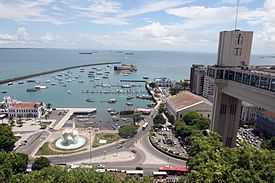Baía de Todos os Santos
| Baía de Todos os Santos All Saints' Bay | |
|---|---|
 Salvador and Baía de Todos os Santos from space, April 1997 | |
| Location | Bahia, Brazil |
| Coordinates | 12°48′S 38°38′E / 12.800°S 38.633°E |
| River sources |
Paraguaçu River Subaé River Jaguaripe River |
| Ocean/sea sources | Atlantic Ocean |
| Basin countries | Brazil |
| Surface area | 1,223 square kilometres (472 sq mi) |
| Average depth | 9.8 metres (32 ft) |
| Settlements | Salvador |
| References | [1] |

Baía de Todos os Santos (All Saints' Bay) is the main and biggest bay of the state of Bahia, Brazil.[2][1] Its name expanded to include a whole province, now known as the state of Bahia), where the city of São Salvador da Bahia de Todos os Santos, now Salvador, was built.[2][1]
Todos os Santos Bay sits on the eastern coast of Brazil, surrounding part of the city of Salvador, and opening to the Atlantic Ocean. It covers 1,223 square kilometres (472 sq mi), making it the second-largest bay in Brazil after the Baía de São Marcos in Maranhão. Todos os Santos is shallow along much of its area with an average depth of 9.8 metres (32 ft). The Paraguaçu River travels 500 kilometres (310 mi) to empty into the bay, and the coastal lowlands of the Reconcavo Basin are at its mouth.[2][1]
Todos os Santos contains 91 islands, the largest being Ilha de Itaparica at its entrance.[1] Farol da Barra (Barra Lighthouse), on the site of a historic fort, stands at the entrance of the bay.[3]
History
Amerigo Vespucci was the first European to visit the bay during his second expedition to the Americas. He entered Todos os Santos on All Saint's Day on November 1, 1502, and named the bay after the feast day; also this reminded him his hometown parish chuch, Ognissanti, Florence, actually dedicated to the Saviour ("San Salvatore").[4] The bay became a point of destination for the African slave trade by the early 18th century.[2]
In 1501, one year after the arrival of Pedro Álvares Cabral's fleet in Porto Seguro, Gaspar de Lemos arrived at Todos os Santos Bay and sailed most of the Bahia coast. But the first European man to disembark in Morro de São Paulo was Martim Afonso de Sousa, in 1531, leading an expedition charged with exploring the coast of the new continent.
In the whaling days, the bay was popular since it was a mating ground for whales.
The northeast shore of Todos os Santos is home to Brazil's first active oil fields. The municipality of São Francisco do Conde, at the north of the bay, remains a port that serves the oil refineries at Mataripe. The bay is dredged from the port to the Atlantic Ocean to remain open to shipping.[2]
References
- ↑ 1.0 1.1 1.2 1.3 1.4 Cirano; Lessa, Guilherme Camargo (2007). "Oceanographic Characteristics Of Baía De Todos Os Santos, Brazil". Revista Brasileira de Geofísica (Sociedade Brasileira de Geofísica) 25 (4): 363–387.
- ↑ 2.0 2.1 2.2 2.3 2.4 "Todos os Santos Bay". Encyclopaedia Britannica. Encyclopaedia Britannica Inc. 2014. Retrieved 2014-12-15.
- ↑ "Histórico" [History] (in Portuguese). Barra, Salvador: Museu Náutico da Bahia. 2014. Retrieved 2014-12-15.
- ↑ "Américo Vespúcio" (in Portuguese). UOL Educaçao. 2014. Retrieved 2014-12-15.
External links
- Map of All Saints Bay in the South of Brazil from the 19th century. (Spanish) (English)